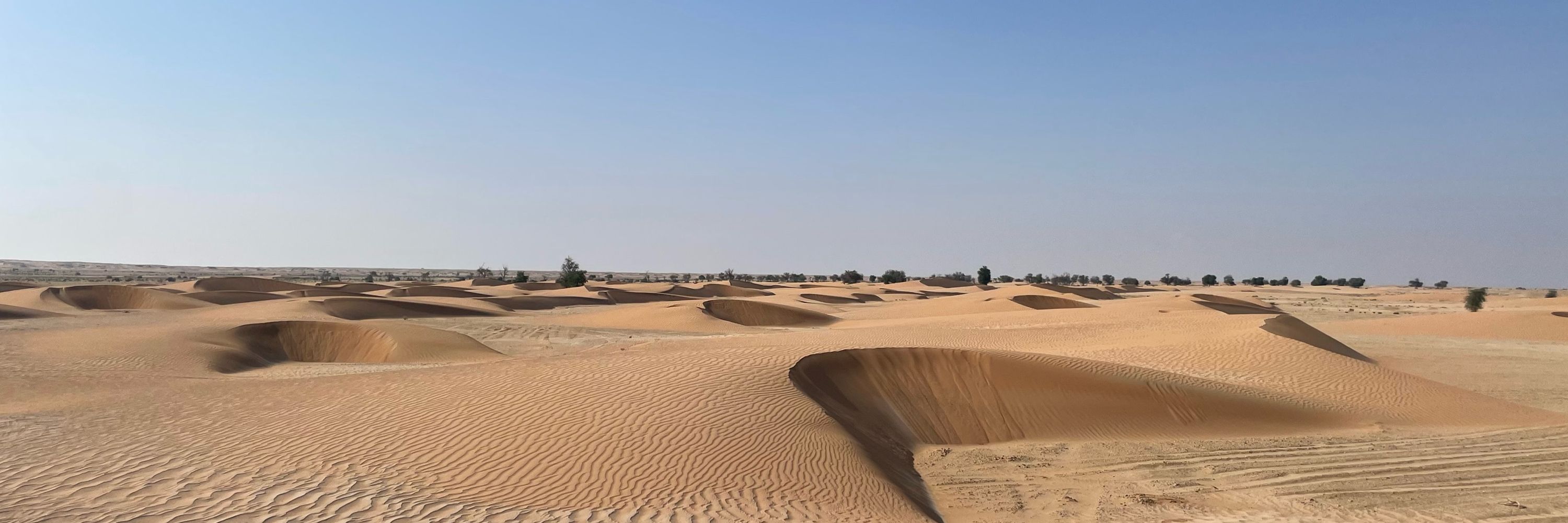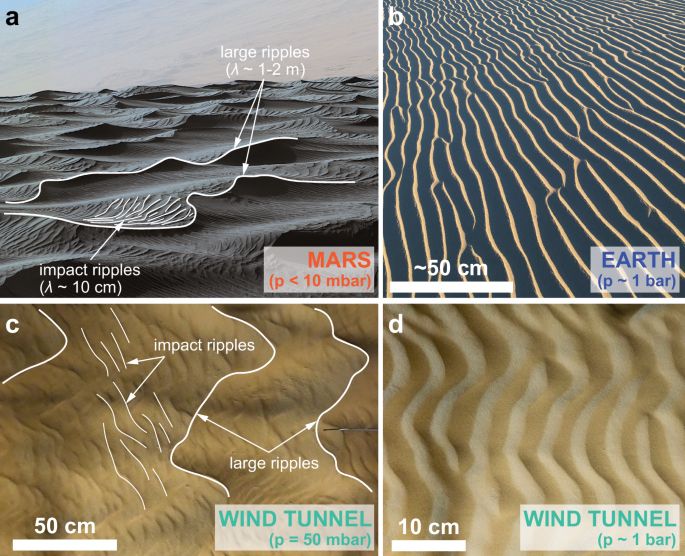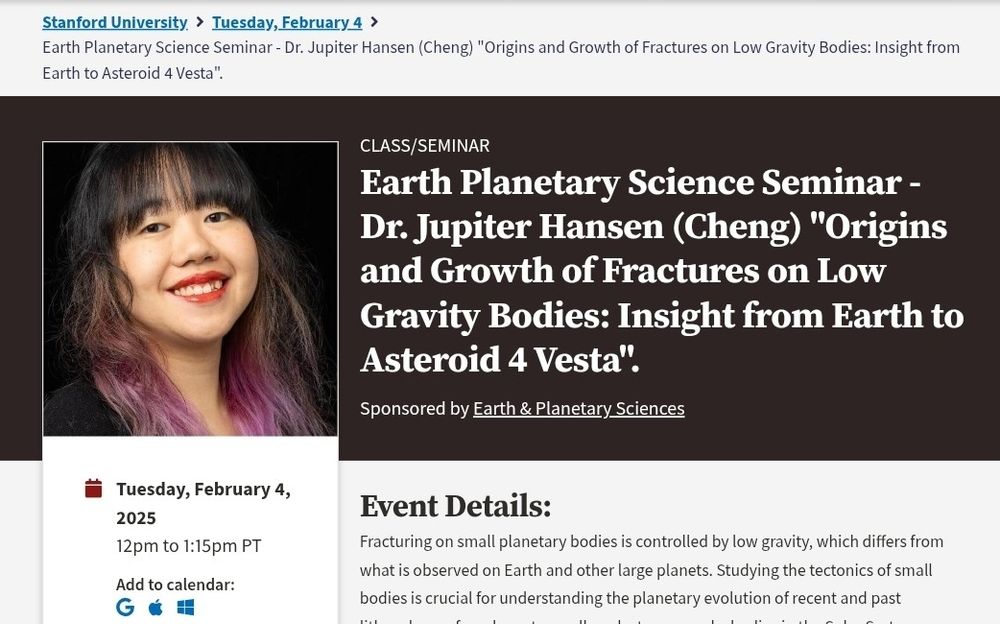
Mathieu Lapôtre
@marslogander.bsky.social
Assistant Prof @ Stanford, Planetary Geologist. I study planetary surface processes and what they can tell us about hydrology, climate, and habitability. 🏳️🌈
http://epsp.stanford.edu
http://epsp.stanford.edu
Reposted by Mathieu Lapôtre
Did you know sand grains record their transport history?
New research in Geology shows zircon grains reveal their journey through microscopic abrasion “microtextures”—even in billion-year-old rocks!
Read more: geosociety.co/4oHG2J6
#Geology #GSAPubs
New research in Geology shows zircon grains reveal their journey through microscopic abrasion “microtextures”—even in billion-year-old rocks!
Read more: geosociety.co/4oHG2J6
#Geology #GSAPubs

November 1, 2025 at 12:32 PM
Did you know sand grains record their transport history?
New research in Geology shows zircon grains reveal their journey through microscopic abrasion “microtextures”—even in billion-year-old rocks!
Read more: geosociety.co/4oHG2J6
#Geology #GSAPubs
New research in Geology shows zircon grains reveal their journey through microscopic abrasion “microtextures”—even in billion-year-old rocks!
Read more: geosociety.co/4oHG2J6
#Geology #GSAPubs
Just out: PhD candidate @mcolinmarvin.bsky.social shows that like in quartz, #zircon grains preserve microscopic archives of their transport history. But unlike in quartz, those archives remain decipherable for billions of years, unlocking first 90% of #Earth ’s history
@stanforddoerr.bsky.social
@stanforddoerr.bsky.social


October 16, 2025 at 4:39 PM
Just out: PhD candidate @mcolinmarvin.bsky.social shows that like in quartz, #zircon grains preserve microscopic archives of their transport history. But unlike in quartz, those archives remain decipherable for billions of years, unlocking first 90% of #Earth ’s history
@stanforddoerr.bsky.social
@stanforddoerr.bsky.social
Reposted by Mathieu Lapôtre
Did you know that sand records its transport history as it moves across Earth's surface? We developed a new tool to investigate billion-year-old rocks by looking at microscopic features on zircon sand grains. Check out our new paper in @geosociety.bsky.social to see how!
doi.org/10.1130/G537...
doi.org/10.1130/G537...


October 16, 2025 at 6:44 AM
Did you know that sand records its transport history as it moves across Earth's surface? We developed a new tool to investigate billion-year-old rocks by looking at microscopic features on zircon sand grains. Check out our new paper in @geosociety.bsky.social to see how!
doi.org/10.1130/G537...
doi.org/10.1130/G537...
Reposted by Mathieu Lapôtre
Over 100 planetary scientists from around the Bay Area recently gathered at Stanford to connect and discuss their research. Highlights:
📸 Laura Schaefer and Michelle Hill
📸 Laura Schaefer and Michelle Hill




September 29, 2025 at 7:28 PM
Over 100 planetary scientists from around the Bay Area recently gathered at Stanford to connect and discuss their research. Highlights:
📸 Laura Schaefer and Michelle Hill
📸 Laura Schaefer and Michelle Hill
Reposted by Mathieu Lapôtre
“I’m doing something that’s merging geology and geochemistry with spacecraft. This is something I’ve been interested in since I was a kid. A lot of people in my field are obsessed with aliens, but I always was obsessed with rocks and planetary bodies.”
Meet Eva L. Scheller, new assistant professor:
Meet Eva L. Scheller, new assistant professor:

Shaping planetary sciences at Stanford
Eva Scheller designs and plans spacecraft instruments, including Mars rovers and satellites, and analyzes the data to understand the formation, evolution, and habitability of planetary bodies.
stanford.io
September 19, 2025 at 9:22 PM
“I’m doing something that’s merging geology and geochemistry with spacecraft. This is something I’ve been interested in since I was a kid. A lot of people in my field are obsessed with aliens, but I always was obsessed with rocks and planetary bodies.”
Meet Eva L. Scheller, new assistant professor:
Meet Eva L. Scheller, new assistant professor:
Reposted by Mathieu Lapôtre
Jusqu’ici, les géologues pensaient que les plantes avaient fait naître les rivières en méandres - ces grands cours d'eau en forme de S. Une nouvelle étude montre qu’elles existaient déjà avant : la végétation a seulement modifié leur façon de bouger 🌱
Explications avec du GIF végétal ⬇️
Explications avec du GIF végétal ⬇️

La végétation a sculpté la forme des rivières
Jusqu’ici, les géologues pensaient que les plantes avaient fait naître les rivières en méandres - ces grands cours d'eau en forme de S. Une nouvelle étude montre qu’elles existaient déjà avant : la vé...
www.radiofrance.fr
September 10, 2025 at 5:27 AM
Jusqu’ici, les géologues pensaient que les plantes avaient fait naître les rivières en méandres - ces grands cours d'eau en forme de S. Une nouvelle étude montre qu’elles existaient déjà avant : la végétation a seulement modifié leur façon de bouger 🌱
Explications avec du GIF végétal ⬇️
Explications avec du GIF végétal ⬇️
Reposted by Mathieu Lapôtre
Findings from a recent study could upend the conventional view of how rivers have shaped continents over time.
It’s “a significant revision to our understanding of the history of the Earth,” said lead author Michael Hasson.
@marslogander.bsky.social
It’s “a significant revision to our understanding of the history of the Earth,” said lead author Michael Hasson.
@marslogander.bsky.social

The rise of plant life changed how rivers move, study shows
Research reveals that unvegetated meandering rivers can geologically masquerade as braided rivers, suggesting they were much more common in the first 90 percent of Earth’s history than previously thou...
stanford.io
August 25, 2025 at 4:08 PM
Findings from a recent study could upend the conventional view of how rivers have shaped continents over time.
It’s “a significant revision to our understanding of the history of the Earth,” said lead author Michael Hasson.
@marslogander.bsky.social
It’s “a significant revision to our understanding of the history of the Earth,” said lead author Michael Hasson.
@marslogander.bsky.social
Plants change how river bends move - paper by PhD student Michael Hasson out as First Release in #Science!!
Paper: doi.org/10.1126/scie...
Before #plants, #meanders did not grow laterally as much but translated downstream, making them look like braided rivers in rocks.
@stanforddoerr.bsky.social
Paper: doi.org/10.1126/scie...
Before #plants, #meanders did not grow laterally as much but translated downstream, making them look like braided rivers in rocks.
@stanforddoerr.bsky.social

Vegetation changes the trajectory of river bends
A primary axiom in geoscience is that the evolution of plants drove global changes in river dynamics. Notably, the apparent sinuosity of rivers, derived from the variance of sediment accretion directi...
doi.org
August 22, 2025 at 7:17 PM
Plants change how river bends move - paper by PhD student Michael Hasson out as First Release in #Science!!
Paper: doi.org/10.1126/scie...
Before #plants, #meanders did not grow laterally as much but translated downstream, making them look like braided rivers in rocks.
@stanforddoerr.bsky.social
Paper: doi.org/10.1126/scie...
Before #plants, #meanders did not grow laterally as much but translated downstream, making them look like braided rivers in rocks.
@stanforddoerr.bsky.social
Reposted by Mathieu Lapôtre
Our results suggest that on Mars, values of the aerodynamic roughness length may reach up to 1 cm—up to two orders of magnitude larger than typically assumed. #NASA Ames, @stanforddoerr.bsky.social, @marslogander.bsky.social
June 2, 2025 at 6:36 PM
Our results suggest that on Mars, values of the aerodynamic roughness length may reach up to 1 cm—up to two orders of magnitude larger than typically assumed. #NASA Ames, @stanforddoerr.bsky.social, @marslogander.bsky.social
Reposted by Mathieu Lapôtre
Excited to share our latest publication in @natcomms.nature.com, where we analyze the aerodynamic roughness length over equilibrated rippled sand beds with active saltation under atmospheric pressures intermediate between those of Earth and Mars.
www.nature.com/articles/s41...
www.nature.com/articles/s41...

Aerodynamic roughness of rippled beds under active saltation at Earth-to-Mars atmospheric pressures - Nature Communications
Low-pressure wind tunnel experiments suggest that the aerodynamic roughness length on Mars, over rippled beds and under active saltation, may be dominated by form drag, reaching values up to two order...
www.nature.com
June 2, 2025 at 6:31 PM
Excited to share our latest publication in @natcomms.nature.com, where we analyze the aerodynamic roughness length over equilibrated rippled sand beds with active saltation under atmospheric pressures intermediate between those of Earth and Mars.
www.nature.com/articles/s41...
www.nature.com/articles/s41...
Postdoc Carlos Alvarez shows that Mars’s large #aeolian #ripples are not impact ripples through low-pressure #wind tunnel experiments at #NASA Ames. Very excited about this one!
@stanforddoerr.bsky.social
www.nature.com/articles/s41...
@stanforddoerr.bsky.social
www.nature.com/articles/s41...

Ripples formed in low-pressure wind tunnels suggest Mars’s large windblown ripples are not impact ripples - Nature Communications
Low-pressure wind tunnel experiments suggest that large sand ripples on Mars are drag ripples, not impact ripples. Windblown drag ripples constitute an untapped record of atmospheric evolution under t...
www.nature.com
March 27, 2025 at 3:48 AM
Postdoc Carlos Alvarez shows that Mars’s large #aeolian #ripples are not impact ripples through low-pressure #wind tunnel experiments at #NASA Ames. Very excited about this one!
@stanforddoerr.bsky.social
www.nature.com/articles/s41...
@stanforddoerr.bsky.social
www.nature.com/articles/s41...
New paper by PhD student @mcolinmarvin.bsky.social uses #patterns formed by #dunes to better understand sources, pathways, and sinks of #sand on #Titan. Spoiler: #Xanadu has outsized influence on #eolian sediments, and sand travels far!!
@stanforddoerr.bsky.social
@stanforddoerr.bsky.social
Check out our paper in @agu.org where we provide evidence for a continuous transport pathway around Titan’s equatorial dune fields, only interrupted by the Xanadu region (with implications for the nature of Titan’s sand grains!) agupubs.onlinelibrary.wiley.com/doi/full/10....

March 5, 2025 at 12:29 AM
New paper by PhD student @mcolinmarvin.bsky.social uses #patterns formed by #dunes to better understand sources, pathways, and sinks of #sand on #Titan. Spoiler: #Xanadu has outsized influence on #eolian sediments, and sand travels far!!
@stanforddoerr.bsky.social
@stanforddoerr.bsky.social
Reposted by Mathieu Lapôtre
I'm giving a talk at Stanford tomorrow! If you're around, come join us. I think Zoom is an option too—details here:
events.stanford.edu/event/earth-...
events.stanford.edu/event/earth-...

February 3, 2025 at 9:02 PM
I'm giving a talk at Stanford tomorrow! If you're around, come join us. I think Zoom is an option too—details here:
events.stanford.edu/event/earth-...
events.stanford.edu/event/earth-...
Mars’ thin atmosphere makes large windblown sand ripples, like water shapes ripples on Earth’s riverbeds!
New paper by @stanforddoerr postdoc @Liorruba, with colleagues R. Ewing @TAMUGeosciences, @LoriKFenton @SETIInstitute, and former postdoc @_algunn now @MonashUni
x.com/NatureComms/st…
New paper by @stanforddoerr postdoc @Liorruba, with colleagues R. Ewing @TAMUGeosciences, @LoriKFenton @SETIInstitute, and former postdoc @_algunn now @MonashUni
x.com/NatureComms/st…
February 26, 2025 at 11:31 PM
Mars’ thin atmosphere makes large windblown sand ripples, like water shapes ripples on Earth’s riverbeds!
New paper by @stanforddoerr postdoc @Liorruba, with colleagues R. Ewing @TAMUGeosciences, @LoriKFenton @SETIInstitute, and former postdoc @_algunn now @MonashUni
x.com/NatureComms/st…
New paper by @stanforddoerr postdoc @Liorruba, with colleagues R. Ewing @TAMUGeosciences, @LoriKFenton @SETIInstitute, and former postdoc @_algunn now @MonashUni
x.com/NatureComms/st…
Congratulations to @mhasson7 for a brilliant qualifying exam!!! First PhD candidate from @StanfordEarth EPSP 🎉🥳 Time to celebrate with @Liorruba, @nilscp, @mcolinmarvin, and @b_amaro_!

February 26, 2025 at 11:31 PM
Congratulations to @mhasson7 for a brilliant qualifying exam!!! First PhD candidate from @StanfordEarth EPSP 🎉🥳 Time to celebrate with @Liorruba, @nilscp, @mcolinmarvin, and @b_amaro_!
A long time coming - “#Mars as a Time Machine to Precambrian Earth” - now open access in J. @GeolSoc! Was such a fun one to write with inspiring coauthors @KirstenSiebach @smtikoo + others not on Twitter.
@StanfordEarth
jgs.lyellcollection.org/content/early/…
@StanfordEarth
jgs.lyellcollection.org/content/early/…
Mars as a time machine to Precambrian Earth | Journal of the Geological Society
As Mars transitioned from an early Earth-like state to the cold desert planet it is today, it preserved a near pristine record of surface environments in a world without plate tectonics and complex life. The records of Mars’ Earth-like surfaces have ...
jgs.lyellcollection.org
February 26, 2025 at 11:31 PM
A long time coming - “#Mars as a Time Machine to Precambrian Earth” - now open access in J. @GeolSoc! Was such a fun one to write with inspiring coauthors @KirstenSiebach @smtikoo + others not on Twitter.
@StanfordEarth
jgs.lyellcollection.org/content/early/…
@StanfordEarth
jgs.lyellcollection.org/content/early/…
Active saltation at Great Sand Dunes NP with @mcolinmarvin and @Liorruba!
@GreatDunesNPS
x.com/mcolinmarvin/s…
@GreatDunesNPS
x.com/mcolinmarvin/s…
February 26, 2025 at 11:31 PM
Active saltation at Great Sand Dunes NP with @mcolinmarvin and @Liorruba!
@GreatDunesNPS
x.com/mcolinmarvin/s…
@GreatDunesNPS
x.com/mcolinmarvin/s…
Just off the press: new paper by former @StanfordEarth postdoc @_algunn, now lecturer @MonashEAE analyzing spatial and temporal patterns in sand accumulation in impact craters on #Mars. Suggests enhanced sediment production in L. Noachian-E. Hesperian!
doi.org/10.1130/G49936…
doi.org/10.1130/G49936…
Accumulation of windblown sand in impact craters on Mars | Geology | GeoScienceWorld
Abstract. Loose sand, blown away from source regions by winds, is transported across Mars's surface into sand sheets and dunes and accumulates within
doi.org
February 26, 2025 at 11:31 PM
Just off the press: new paper by former @StanfordEarth postdoc @_algunn, now lecturer @MonashEAE analyzing spatial and temporal patterns in sand accumulation in impact craters on #Mars. Suggests enhanced sediment production in L. Noachian-E. Hesperian!
doi.org/10.1130/G49936…
doi.org/10.1130/G49936…
Loved working with @mike_malaska and @starsarecalling on my first #Titan paper! We propose that a global sedimentary cycle, driven by seasons, could explain the distribution of Titan’s landscapes. Model inspired by how ooids form on Earth (cc: @lizzy_t)
@StanfordEarth @NASAJPL
x.com/stanforddoerr/…
@StanfordEarth @NASAJPL
x.com/stanforddoerr/…
February 26, 2025 at 11:30 PM
Loved working with @mike_malaska and @starsarecalling on my first #Titan paper! We propose that a global sedimentary cycle, driven by seasons, could explain the distribution of Titan’s landscapes. Model inspired by how ooids form on Earth (cc: @lizzy_t)
@StanfordEarth @NASAJPL
x.com/stanforddoerr/…
@StanfordEarth @NASAJPL
x.com/stanforddoerr/…
A really cool study led by Dave Rubin I’ve had a lot of fun participating in. We showed that Mars’ atmosphere had thinned (at least temporarily) before the last episode of subaqueous deposition in Gale crater!
#Mars @MarsCuriosity @StanfordEarth
x.com/jgrplanets/sta…
#Mars @MarsCuriosity @StanfordEarth
x.com/jgrplanets/sta…
February 26, 2025 at 11:30 PM
A really cool study led by Dave Rubin I’ve had a lot of fun participating in. We showed that Mars’ atmosphere had thinned (at least temporarily) before the last episode of subaqueous deposition in Gale crater!
#Mars @MarsCuriosity @StanfordEarth
x.com/jgrplanets/sta…
#Mars @MarsCuriosity @StanfordEarth
x.com/jgrplanets/sta…
Undergrads interested in #planetary surface processes, impact cratering, and #MachineLearning are invited to apply to @StanfordEarth‘s SURGE summer program (deadline Feb 4)! Come work with us! A list of projects is available @🌔☄️🪨💻
earth.stanford.edu/dei/surge#gs.n…
earth.stanford.edu/dei/surge#gs.n…
Sustainability Undergraduate Research in Geoscience and Engineering Program (SURGE)
Join us this summer for 8 weeks of fully funded mentored research and graduate school preparation. SURGE is a program for undergraduate students who are new to research and want to explore the field of sustainability in a community that celebrates inclusion. SURGE is funded in part by the National Science Foundation and the Stanford Doerr School of Sustainability.
earth.stanford.edu
February 26, 2025 at 11:30 PM
Undergrads interested in #planetary surface processes, impact cratering, and #MachineLearning are invited to apply to @StanfordEarth‘s SURGE summer program (deadline Feb 4)! Come work with us! A list of projects is available @🌔☄️🪨💻
earth.stanford.edu/dei/surge#gs.n…
earth.stanford.edu/dei/surge#gs.n…
Having LOTS of technical difficulties at #AGU21 this morning but that won’t stop us! Pic of @radjanirad being creative here to allow those on Zoom to see her slides 😅

February 26, 2025 at 11:30 PM
Having LOTS of technical difficulties at #AGU21 this morning but that won’t stop us! Pic of @radjanirad being creative here to allow those on Zoom to see her slides 😅
Don’t take all the credit @SarcasticRover, you were helped by hundreds of other government employees @NASA here on Earth! 😜
x.com/SarcasticRover…
x.com/SarcasticRover…
February 26, 2025 at 11:30 PM
Don’t take all the credit @SarcasticRover, you were helped by hundreds of other government employees @NASA here on Earth! 😜
x.com/SarcasticRover…
x.com/SarcasticRover…

